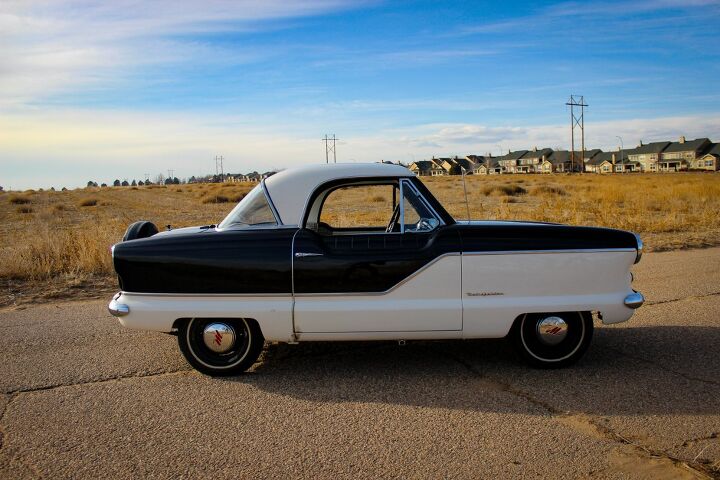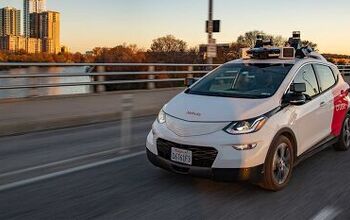Rare Rides: A Microscopic American Motors Metropolitan From 1962

Recently, we featured a grandiose convertible Hudson once owned by actor and car enthusiast Steve McQueen. Today’s Rare Ride came originally from Nash, the other company which combined with Hudson to form American Motors.
Let’s get Metropolitan.
Like early Hudson, the Nash Motor Company focused on how to make cars more economical and affordable for the average consumer. Nash based the Metropolitan on ideas from its prior concept car, the NXI (Nash Experimental International). As the company had no delusions about the Metropolitan’s size, it was not marketed as a primary car. The intent was for the Metropolitan to take up the secondary space in the driveway, doing short errands around town. At the time, the term subcompact did not yet exist, so the Metropolitan was labeled as a compact or economy car.
With the design ready for market, the people at Nash first needed someone to build it. The automaker’s consumer studies showed that Americans were ready to purchase a small economy car — as long as it was very cheap. Accountants determined it would not be possible to build the Metropolitan domestically due to high labor costs. So they turned to an island to the east.
That’d be England. In 1952, Nash announced the selection Austin Motors to build the Metropolitan for them. It was a first in the industry: A car intended for the North American market was built overseas, then sold and serviced by Nash dealers. It was the very first captive import.
Metropolitans were available as hardtop coupes or convertibles and had a considerable standard features list considering the class of car. Nash put the car on sale in 1953 and immediately targeted its best prospective customer — women. Nash’s car for women beat Dodge and the La Femme to market by a year. Luxury, affordability, and personal transport were all highlighted as features of this all-new kind of car.
The revolutionary Metropolitan found favor with critics and customers alike. Through the next several years, the car went through three major revisions. The final Series IV started production early in 1959, adding an opening trunk to the Metropolitan for the first time. There were also vent windows at the front and the most advanced version of the Austin B-Series engine, which displaced 1.5 liters and produced a racy 55 horsepower. All Metropolitans had a three-speed manual, in addition to fuel economy that ranged between 30 and 39 miles per gallon — a very commendable figure in the Fifties.
1959 would prove the high point in the Metropolitan’s life, when it racked up over 22,000 sales. The only compact car which trumped it was the ever-present VW Beetle. Sales fell off quickly after that, as the aging Metropolitan faced steep competition from within its own showroom. AMC offered a Rambler American line that was larger, newer, and cost $100 more than the Metropolitan.
The company wound down production in 1961, when sales dropped to just 969 total units between the U.S. and Canada. A select remainder were sold as ’62 models; 420 in total.
That brings us to today’s Rare Ride — the last of the last in the Metropolitan’s history. A 1962 model in black and white, it isn’t perfect, but wears a nice diamond pattern interior. This Nash can be yours for $7,900.
[Images: seller]

Interested in lots of cars and their various historical contexts. Started writing articles for TTAC in late 2016, when my first posts were QOTDs. From there I started a few new series like Rare Rides, Buy/Drive/Burn, Abandoned History, and most recently Rare Rides Icons. Operating from a home base in Cincinnati, Ohio, a relative auto journalist dead zone. Many of my articles are prompted by something I'll see on social media that sparks my interest and causes me to research. Finding articles and information from the early days of the internet and beyond that covers the little details lost to time: trim packages, color and wheel choices, interior fabrics. Beyond those, I'm fascinated by automotive industry experiments, both failures and successes. Lately I've taken an interest in AI, and generating "what if" type images for car models long dead. Reincarnating a modern Toyota Paseo, Lincoln Mark IX, or Isuzu Trooper through a text prompt is fun. Fun to post them on Twitter too, and watch people overreact. To that end, the social media I use most is Twitter, @CoreyLewis86. I also contribute pieces for Forbes Wheels and Forbes Home.
More by Corey Lewis
Latest Car Reviews
Read moreLatest Product Reviews
Read moreRecent Comments
- SCE to AUX Range only matters if you need more of it - just like towing capacity in trucks.I have a short-range EV and still manage to put 1000 miles/month on it, because the car is perfectly suited to my use case.There is no such thing as one-size-fits all with vehicles.
- Doug brockman There will be many many people living in apartments without dedicated charging facilities in future who will need personal vehicles to get to work and school and for whom mass transit will be an annoying inconvenience
- Jeff Self driving cars are not ready for prime time.
- Lichtronamo Watch as the non-us based automakers shift more production to Mexico in the future.
- 28-Cars-Later " Electrek recently dug around in Tesla’s online parts catalog and found that the windshield costs a whopping $1,900 to replace.To be fair, that’s around what a Mercedes S-Class or Rivian windshield costs, but the Tesla’s glass is unique because of its shape. It’s also worth noting that most insurance plans have glass replacement options that can make the repair a low- or zero-cost issue. "Now I understand why my insurance is so high despite no claims for years and about 7,500 annual miles between three cars.







































Comments
Join the conversation
As a teenager, I had a neighbor that owned two Mets, and I helped him restore one of them. Before the trunklid was added to these, access to the trunk was gained by lowering the folding, lockable rear seatback.
The 1st shop that I worked at in the early 1970s repaired anything, from school buses to Ferrari's. Some customers were into what were then known as quirky or weird cars. We worked on several Metropolitan's during the two years I was there. One came in on a tow truck as the engine needed an overhaul. While this job was in progress the car owner visited most every day to check the progress and admire his, new to him, Nash. Just as the Nash motor was being completed and ready to go out the door someone brought in a well used postal delivery 3 wheeler for repair, probably a Cushman Mailster. When the Metro owner saw this he immediately wanted to sell the Metro and get a 3 wheeler.